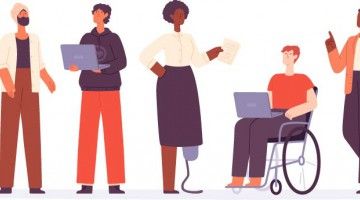Plain-language summaries
Institute for Work & Health (IWH) plain-language summaries condense research findings in various formats. At Work articles explain study results with comments from the study leads. Research Highlights summarize journal articles in easy-to-read, digest formats. Sharing Best Evidence summaries highlight findings from systematic reviews and other types of reviews conducted or led by IWH researchers. Issue Briefings discuss key research findings from IWH or elsewhere on topics that are of particular interest to policy-makers.

At Work article
IWH tool comes out ahead in Australian study of OHS leading indicator tools
The Institute’s OHS Vulnerability Measure was one of two tools recommended by Monash University evaluation team for use by state workers’ compensation board
Published:

At Work article
One in four young adults in the U.S. have poor mental health—and the lowest earnings among their peers
Study by IWH researcher maps mental health and earnings trajectories, from participants’ mid-teens to mid-30s
Published:

At Work article
Employers struggle to provide newcomers with OHS training, support: IWH study
Smaller workplaces especially challenged by need for training resources in different languages and by limited OHS capacity, study finds
Published:

At Work article
Older workers not prone to ask for employer support, citing ageism and other issues
A study by IWH finds concerns about privacy, reputation, job loss among reasons older workers are not inclined to share they need support to keep working
Published:

At Work article
Study of educators during pandemic found psychosocial conditions worse for those teaching online
OHCOW-IWH study also found two-thirds of surveyed teachers reported having less than half of needed COVID protections
Published:

At Work article
IWH study finds 7 in 10 injured workers still experience pain more than a year after injury
Link between pain severity and time off work also found in study of Ontario injured workers, conducted 18 months post-injury
Published:

Research Highlights
Examining the link between job insecurity, work limitations and persistent symptoms among young adults with rheumatic disease
Young adults with rheumatic disease who reported high work activity limitations were also more likely to report persistent high levels of pain, fatigue and active rheumatic disease symptoms. Those who experienced job insecurity were more likely to report persistent pain and active disease symptoms. That's according to an IWH follow-up study conducted over 27 months.
Published:

Research Highlights
Comparing real-time online work-related training with face-to-face formats
Work-related training delivered through synchronous or real-time online formats can be just as effective as face-to-face training in building workers’ knowledge or skills. This finding is based on a relatively sparse body of research looking at training aimed at adult learners at the undergraduate level or higher.
Published:

At Work article
IWH estimates point to positive return on OHS investment in three Ontario sectors
The Institute’s method to estimate the ROI of occupational health and safety spending includes intangible benefits
Published:

Research Highlights
Getting the message right: strategies to improve return-to-work communication
Communication is central to disability management—especially in large and complex organizations where multiple parties are involved in the return-to-work process and inconsistent practices can add to communication challenges. Workplace stakeholders in large and complex organizations use key strategies to effectively communicate about RTW. They include communicating messages of support, correctly timing RTW communication, carefully wording messages, framing messages and tailoring messages for individual workers.
Published:

Research Highlights
Working conditions for Greater Toronto Area personal support workers during the COVID-19 pandemic
Personal support workers (PSWs) faced a range of challenges related to the COVID-19 pandemic, including concerns of contracting or transmitting the virus, reduced work hours and income, loss of childcare services and lack of paid sick leave. While the pandemic highlighted the importance of the PSW workforce to the Canadian health-care system, pre-existing poor working conditions—in particular, insecure jobs with few benefits—exacerbated COVID-19-related work experiences.
Published:

At Work article
Workers doing vigorous, tiring activity all day no healthier than those who are least active
A study by IWH finds six patterns of daily movement among Canadians, all but one associated with lower heart risks when compared to the most sedentary
Published:

At Work article
What research can do: IWH input contributes to enhancement of WSIB’s Health and Safety Index
When the WSIB reviewed its Health and Safety Index, IWH researchers provided advice on index methodology. An impact case study summarizes how enhancements to the index in October 2021 incorporated that advice
Published:

At Work article
Widely used survey lacks ability to tell apart 13 distinct psychosocial work factors
IWH and OHCOW study on the measurement properties of Guarding Minds @ Work finds it unable to isolate different psychosocial work dimensions
Published:

At Work article
Review synthesizes differences between men, women in injury risks and outcomes
IWH systematic review finds differences in the same occupations, likely due to differences in job tasks
Published:

Issue Briefing
Estimating the financial return on employers’ investments in the prevention of work injuries in Ontario
Following a 2017 study to estimate occupational health and safety (OHS) expenditures by employers with 20 or more employees in Ontario, Canada, an Institute for Work & Health (IWH) team has set out to estimate the financial return on those OHS expenditures. This Issue Briefing shares findings from that follow-up study.
Published:

At Work article
How government funding can best support the employment of persons with disabilities
IWH project highlights key features of financial incentives that are most helpful in supporting sustained employment of persons with disabilities
Published:

At Work article
Cannabis use linked to higher injury risk, but only among those who use at or before work
IWH study finds injury risk doubles among workers who use cannabis before or at work, but no increase among those who use outside of work
Published:

At Work article
Over a third of work-related ER visits in Ontario don’t show up as WSIB claims
Study by Institute for Work & Health uses linkage between WSIB claims data and Ontario’s emergency department records to examine patterns of under-reporting
Published:

At Work article
Poor interactions with case managers linked with risk of mental illness later on
New Ontario study finds claimants who report poor treatment by case managers face higher risk of serious psychological distress 18 months post-injury
Published: